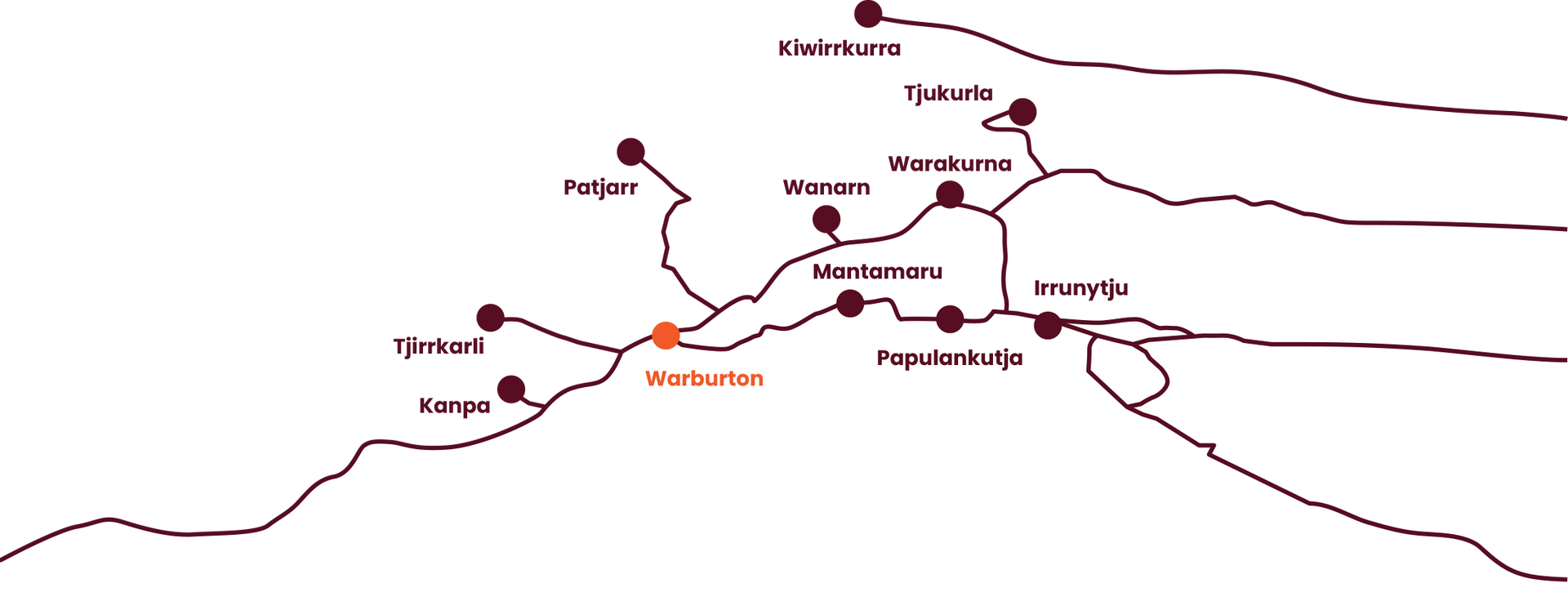Warburton (Ranges)
Warburton or Mirlirrtjarra is named after the range of hills (Warburton Ranges) to the north of the community which in turn was named after one of the early European explorers who travelled this region in search of good pastoral land. The community is colloquially referred to as Ranges.
Welcome to Warburton
Warburton or Mirlirrtjarra is named after the range of hills (Warburton Ranges) to the north of the community. Warburton is the largest of the Ngaanyatjarra Communities and is considered the metropolis of the Lands.
The community which in turn was named after one of the early European explorers who travelled this region in search of good pastoral land. The community is colloquially referred to as Ranges. The other name for the community is Mirlirrtjarra which is the name of a site nearby. Warburton is the largest of the Ngaanyatjarra Communities and is considered the metropolis of the Lands.
Warburton was the first Community to be established on the Lands as a result of the activities of the United Aboriginal Missionaries (UAM) Will and Iris Wade, who established a base at Warburton in the 1930’s. Prior to the establishment of the Warburton Mission, Yarnangu led a nomadic subsistence life. The movement of people away from this life to a sedentary one at Warburton Mission was a gradual process that began with people's visits to the mission prompted initially by curiosity and then the promise of food, blankets, medicines and other material items. Later, a prolonged drought drew people into the mission.
In the early days of the mission, rations were given to yarnangu in exchange for dingo scalps that the missionaries traded for money on their regular trips into the goldfields town of Laverton. This money was then used to buy rations that were trucked back to the mission. This trade was lucrative enough to allow the missionaries to establish a school, a dormitory system, a church, a hospital and several cottage industries. Their main objectives included converting Yarnangu to Christianity and providing them with education, employment and training programs. The ability of the mission to supply Yarnangu with food, blankets, tools and other material items meant that Yarnangu did not need to travel to the goldfields region for trading purposes. As a result the mission stemmed the outward migration that was occurring in this part of the Desert both prior and in the first few decades of the twentieth century.
In the 1950's the government began providing funding in the form of rations. A short time later they began supporting the education initiatives of the mission. Although an assimilation policy was being rigorously pursued in most part of Australia at this time, the remoteness of this region and lack of funding (which translated as lack of personnel) meant a minimal of interference and change occurred. However, the movement of people onto missions and government settlements (Docker River, Areyonga, Haasts Bluff, Papunya) was certainly in line with government assimilations policies of the 50s and 60s.
From the 1970s onwards there were changes in government policy away from assimilation and towards self-determination and self-management. In 1973 the UAM relinquished control of the Warburton Mission to the incorporated Warburton Aboriginal Community with an elected Aboriginal council. In 1981 the Ngaanyatjarra Council was officially incorporated. Warburton, Irrunytju, Warakurna, Jameson and Blackstone were the first members of the Council.
Community Contacts
Warburton Community Services Manager (CSM)
Warburton Clinic
Email: warburton@nghealth.org.au
Warburton Essential Services Workshop
Tel: 08 8956 7313
NG Services Workshop
Tel: 08 8956 7740
Warburton Office Managers
Warburton Police
Tel: 08 8956 7740
Warburton Roadhouse Manager
Warburton School
Tel: 08 8956 7651








